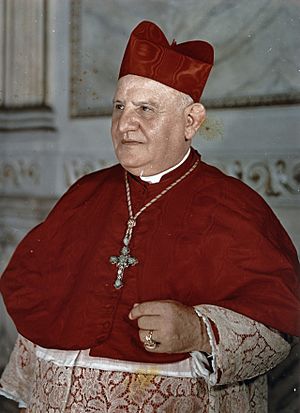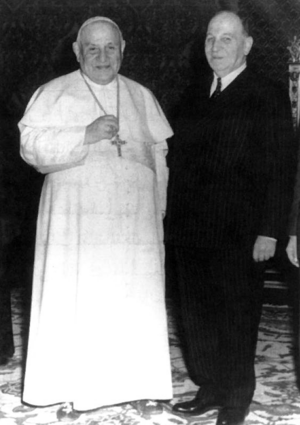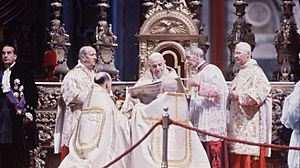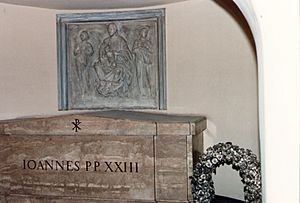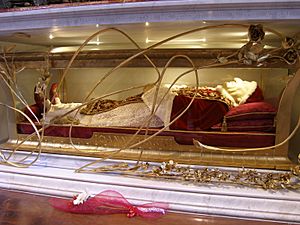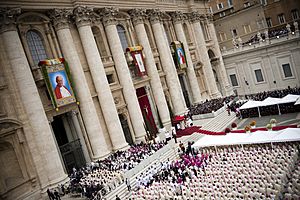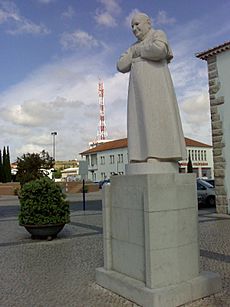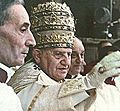Pope John XXIII facts for kids
Quick facts for kids Pope Saint John XXIII |
|
|---|---|
| Bishop of Rome | |
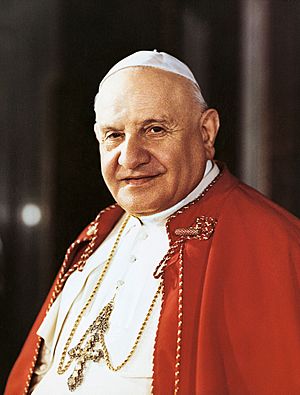
Official photograph, 1958-63
|
|
| Church | Catholic Church |
| Papacy began | 28 October 1958 |
| Papacy ended | 3 June 1963 |
| Predecessor | Pius XII |
| Successor | Paul VI |
| Orders | |
| Ordination | 10 August 1904 |
| Consecration | 19 March 1925 by Giovanni Tacci Porcelli |
| Created Cardinal | 12 January 1953 |
| Personal details | |
| Birth name | Angelo Giuseppe Roncalli |
| Born | 25 November 1881 Sotto il Monte, Bergamo, Kingdom of Italy |
| Died | 3 June 1963 (aged 81) Apostolic Palace, Vatican City |
| Previous post |
|
| Education |
|
| Motto | Oboedientia et Pax (Obedience and Peace) |
| Signature | |
| Coat of arms |  |
| Sainthood | |
| Feast day |
|
| Venerated in |
|
| Beatified | 3 September 2000 Saint Peter's Square, Vatican City by Pope John Paul II |
| Canonized | 27 April 2014 Saint Peter's Square, Vatican City by Pope Francis |
| Attributes |
|
| Patronage |
|
| Other Popes named John | |
Pope John XXIII (born Angelo Giuseppe Roncalli; 25 November 1881 – 3 June 1963) led the Catholic Church and was the ruler of Vatican City from 1958 until his death. He was born into a family of farmers in a small Italian village.
Angelo Giuseppe Roncalli became a priest in 1904. He served in various important roles around the world. These included being a nuncio (a Vatican ambassador) in France and a delegate in countries like Bulgaria, Greece, and Turkey. In 1953, Pope Pius XII made him a cardinal and the Patriarch of Venice.
In 1958, at 76 years old, Roncalli was unexpectedly chosen as Pope. He took the name John XXIII. Many thought he would be a temporary Pope, but he surprised everyone by calling the important Second Vatican Council in 1962. This council brought big changes to the Catholic Church.
Pope John XXIII believed strongly in equality, saying, "We were all made in God's image, and thus, we are all Godly alike." He wanted to modernize the Church and help it connect with other Christian faiths. He also worked to improve relations with communist countries in Eastern Europe. He was known for being a traditionalist in beliefs but open to new ways of dealing with social and political issues. He increased the number of cardinals and appointed the first cardinals from Africa, Japan, and the Philippines.
He passed away before the Vatican Council finished. His journey to becoming a saint began in 1965. In 2013, Pope Francis declared him a saint because of his good life and the positive changes he started with the Second Vatican Council. He was made a saint on April 27, 2014. Today, Pope John XXIII is lovingly called the Good Pope.
Contents
Early Life and Education
Angelo Giuseppe Roncalli was born on November 25, 1881. His birthplace was Sotto il Monte, a small village in the Lombardy region of Italy. He was the fourth of thirteen children in his family. His parents were Giovanni Battista Roncalli and Marianna Giulia Mazzola.
His family worked as sharecroppers, which meant they farmed land owned by others. This was common in his village. In 1889, at age 8, Angelo received his First Communion and Confirmation.
In 1896, he joined the Secular Franciscan Order. He made his vows to this order in 1897. In 1904, Roncalli earned his doctorate in canon law. He was then ordained a priest in Rome on August 10. Soon after, he met Pope Pius X at St. Peter's Basilica.
Becoming a Priest
In 1905, Giacomo Radini-Tedeschi, the new Bishop of Bergamo, chose Roncalli as his secretary. Roncalli worked for the bishop until his death in 1914. Bishop Radini-Tedeschi's last words to Roncalli were "Angelo, pray for peace." This deeply affected Roncalli. During this time, he also taught at the local seminary in Bergamo.
During World War I, Roncalli served in the Royal Italian Army. He worked as a stretcher-bearer in the medical corps and as a chaplain. After leaving the army in 1919, he became a spiritual director at the seminary. In 1921, he was given the title Monsignor. Later that year, Pope Benedict XV appointed him as the Italian president of the Society for the Propagation of the Faith.
Serving as a Bishop
In 1925, Pope Pius XI appointed Roncalli as the Vatican's representative to Bulgaria. On March 19, he became a bishop. He was consecrated by Giovanni Tacci Porcelli in Rome.
In 1934, he was appointed the Vatican's representative to Turkey and Greece. He became known in Turkey as "the Turcophile Pope" because of his friendly approach. Roncalli used his position to help Jewish people during The Holocaust in World War II. He helped thousands of refugees escape danger.
In 1939, his mother passed away. He was unable to be with her because he had to stay at his post until a new Pope was elected after Pope Pius XI's death. Roncalli was happy when Pope Pius XII was chosen as the new Pope.
Helping During the Holocaust
As a Vatican representative, Roncalli worked hard to save refugees, mostly Jewish people, from the Nazis during World War II. Here are some of his efforts:
- He helped deliver "immigration certificates" to Palestine.
- He helped rescue Jews using "baptism of convenience" certificates.
- He helped Jewish children leave Slovakia.
- He intervened to free Jews held in the Jasenovac concentration camp.
- He asked King Boris III of Bulgaria to stop the deportation of Bulgarian Jews.
- He helped Romanian Jews leave Transnistria.
- He helped Italian Jews through the Vatican.
- He helped orphaned children from Transnistria reach Palestine by ship.
- He helped save Jews from the Sereď concentration camp.
- He helped Hungarian Jews convert to Christianity to save themselves.
In 2000, the International Raoul Wallenberg Foundation started a campaign to recognize Roncalli's humanitarian actions. They submitted a large file in 2011 to Yad Vashem, asking for him to be recognized as Righteous Among the Nations.
Relations with Israel
After 1944, Roncalli actively supported the Catholic Church in helping to establish the State of Israel. He saw Jewish immigration to Palestine as a humanitarian issue. He was one of the Vatican's most understanding diplomats regarding the fate of Jews after the war.
Serving in France
In 1944, Pope Pius XII appointed him as the new Vatican representative to France. His job was to help manage the retirement of bishops who had worked with the German occupying forces. Roncalli left Turkey for France in December 1944 to begin his new role.
Becoming a Cardinal
In November 1952, Roncalli learned that Pope Pius XII planned to make him a cardinal. He was also chosen to become the new Patriarch of Venice. On January 12, 1953, he was officially made a Cardinal-Priest and the Patriarch of Venice.
Before leaving Paris, he had dinner with the eight men who had served as prime minister during his time as Vatican representative. The President of France, Vincent Auriol, honored Roncalli by giving him the red cardinal's hat. Auriol also awarded him the Legion of Honour.
Roncalli moved into the patriarch's residence in Venice. He chose to live on the second floor. He did not want to live in the first-floor room where Pope Pius X had once lived.
In 1958, he held a special meeting for his diocese in Venice.
Papacy
Papal Election
After Pope Pius XII died in October 1958, cardinals gathered to choose a new Pope. Roncalli knew he might be chosen. After eleven rounds of voting, he was elected Pope on October 28, 1958. Many thought he would be a short-term Pope because of his age.
When asked what name he would take, Roncalli surprised everyone by choosing "John." This name had not been used by a Pope for over 500 years. He explained he chose it in memory of France and a past Pope John. He confirmed he was John XXIII, meaning a previous "Antipope John XXIII" was not a true Pope.
His coronation took place on November 4, 1958. He wore a special crown called the 1877 Palatine Tiara.
John XXIII later joked about his appearance. He said that after seeing himself in his new robes, he thought, "this man will be a disaster on television!"
Visits Around Rome
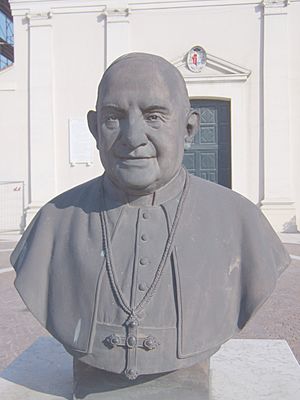
On December 25, 1958, Pope John XXIII made history. He became the first Pope since 1870 to visit places in his own Diocese of Rome. He visited children with polio at a hospital. The next day, he visited a prison. He told the inmates, "You could not come to me, so I came to you." These visits were a big deal.
He also stopped using the formal "we" when talking about himself. He spoke to people in a more personal way. The media noticed this and said he "talked to the youths in their own language."
"Ostpolitik" and Eastern Europe
In international matters, Pope John XXIII started an "Eastern policy." This meant he began talking with communist countries in Eastern Europe. He worked to improve relations between the Vatican and the Russian Orthodox Church. He also tried to prevent nuclear war and improve relations between the Soviet Union and the United States. He wanted to help Catholics in Eastern Europe who were facing difficulties.
Relations with Jewish People
One of Pope John XXIII's first actions was in 1960. He removed a word that described Jews as "faithless" from a special prayer. He also apologized for the Church's past anti-semitism.
During the Second Vatican Council, he asked Cardinal Augustin Bea to create important documents. These documents aimed to improve relations with Jewish people.
Calling the Council
Pope John XXIII surprised everyone by calling for an ecumenical council. This was announced on January 25, 1959. This council, known as the Second Vatican Council, brought major changes to the Catholic Church. These changes included new ways of celebrating Mass and a stronger focus on ecumenism (working with other Christian faiths).
Before the council started, John XXIII visited Assisi and Loreto in October 1962. He prayed for the success of the new council. He was the first Pope to travel outside of Rome since Pope Pius IX. Crowds greeted him along the way.
Human Rights
Pope John XXIII strongly supported human rights. He wrote about these rights in his important letter called Pacem in terris. He said that everyone has the right to live and have basic needs met. These include food, clothing, shelter, medical care, and rest. He also said people have the right to be cared for if they are sick, disabled, or unemployed.
Papal Ceremonies
Pope John XXIII was the last Pope to use all the traditional papal ceremonies. Some of these ceremonies were changed or stopped after the Second Vatican Council. His papal coronation lasted the traditional five hours. He wore different papal tiaras, including the one from his coronation. The people of Bergamo gave him a special silver tiara. He asked that half the jewels be removed and the money given to the poor.
Liturgical Changes
Pope John XXIII continued to make small changes to the way Mass was celebrated. He published changes that led to the 1962 Roman Missal. This was the last official version of the traditional Mass.
New Saints and Blesseds
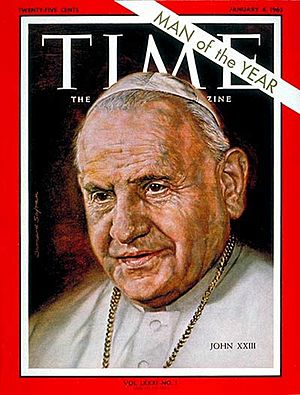
During his time as Pope, John XXIII declared four individuals "Blessed." This is a step before becoming a saint. He also canonized (declared saints) several people. These included Martin de Porres and Elizabeth Ann Seton.
He also named Saint Lawrence of Brindisi a "Doctor of the Church." This is a special title given to saints who have made important contributions to theology.
Creating Cardinals
The Pope created 52 new cardinals during his time. He decided to increase the number of cardinals beyond the traditional limit of seventy. He also wanted to make the group of cardinals more international. He appointed the first cardinals from countries like Japan and Tanzania. In 1962, he made a rule that all cardinals should be bishops.
Second Vatican Council: First Session
On October 11, 1962, the first session of the Second Vatican Council began. Pope John XXIII gave an important opening speech. After the first session ended, people gathered in St. Peter's Square and cheered for the Pope.
Pope John XXIII appeared at his window and spoke to the crowd. He told them to go home and hug their children, saying the hug came from the Pope. This speech became known as the "Speech of the Moon." The first session ended on December 8, 1962.
Final Months and Death
In September 1962, Pope John XXIII was diagnosed with stomach cancer. This news was kept private. He looked pale and tired, hinting at his illness. In April 1963, he told visitors, "That which happens to all men perhaps will happen soon to the Pope who speaks to you today."
During the Cuban Missile Crisis in October 1962, Pope John XXIII offered to help resolve the conflict. Both US President John F. Kennedy and Nikita Khrushchev praised him for his efforts for peace. Khrushchev even sent him a message wishing him well. John XXIII became the first Pope to be named Time magazine's "Man of the Year."
On May 10, 1963, John XXIII received the Balzan Prize for his work for peace. He suffered severe stomach pains on his way to the ceremony but insisted on attending. This was his last public appearance.
By late May 1963, his health worsened. He needed blood transfusions. His doctors told him that his cancer was very serious. His family came to be with him.
Pope John XXIII passed away on June 3, 1963, at 81 years old. He died as a Mass for him finished in St. Peter's Square. After his death, the Italian government declared three days of mourning. He was buried on June 6 in the Vatican grottos.
In December 1963, US President Lyndon B. Johnson honored him. He was given the Presidential Medal of Freedom, America's highest civilian award. This recognized his efforts for peace and human dignity.
Becoming a Saint
| Pope Saint John XXIII Bishop of Rome |
|
|---|---|
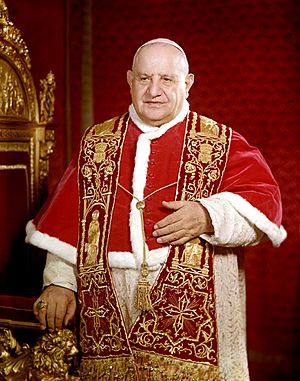 |
|
| Pope and Confessor | |
| Born | 25 November 1881 Sotto il Monte, Bergamo, Kingdom of Italy |
| Died | 3 June 1963 (aged 81) Apostolic Palace, Vatican City |
| Venerated in |
|
| Beatified | 3 September 2000, St. Peter's Square, Vatican City by Pope John Paul II |
| Canonized | 27 April 2014, St. Peter's Square, Vatican City by Pope Francis |
| Feast | 11 October |
| Attributes | Papal Vestments, Papal Tiara, Camauro |
| Patronage | Patriarchy of Venice, Papal Delegates, Second Vatican Council, Christian Unity, Diocese of Bergamo, Sotto il Monte, Valsamoggia, Italian Army |
Pope John XXIII was lovingly known as "the Good Pope." The process to make him a saint began in 1965. On September 3, 2000, Pope John Paul II declared him "Blessed." This happened after a miracle was recognized: the curing of an ill woman.
After he was declared Blessed, his body was moved. It was placed in the altar of St. Jerome in St. Peter's Basilica for people to see. His body was found to be very well preserved. The Church says this was due to embalming and the sealed coffin, not a miracle.
On June 3, 2013, Pope Francis visited John XXIII's tomb to mark the 50th anniversary of his death. A month later, Pope Francis approved John XXIII for sainthood. He did this without the usual second miracle. Instead, he based it on John XXIII's important work with the Second Vatican Council. On April 27, 2014, John XXIII and Pope John Paul II were both declared saints.
His feast day is celebrated on October 11. This date marks the anniversary of the opening of the Second Vatican Council.
Legacy
From his teenage years, John XXIII kept a diary of his spiritual thoughts. This diary was later published as Journal of a Soul. It shows his goals to "grow in holiness" throughout his life, even as Pope.
Many schools and colleges around the world are named after him. These include John XXIII College (Perth) in Australia and Roncalli College in New Zealand. There are also Roncalli High Schools in the United States.
In 2019, Pope Francis mentioned John XXIII's letter Pacem in terris. He called it a "code of conduct" for peace among different religions.
Sacred Heart University in Connecticut has a residence hall named Angelo Roncalli Hall.
See also
 In Spanish: Juan XXIII para niños
In Spanish: Juan XXIII para niños
- Cardinals created by John XXIII
- Eastern Catholic Churches
- Eastern Orthodox Church
- List of Catholic saints
- List of encyclicals of Pope John XXIII
- List of popes
Images for kids



